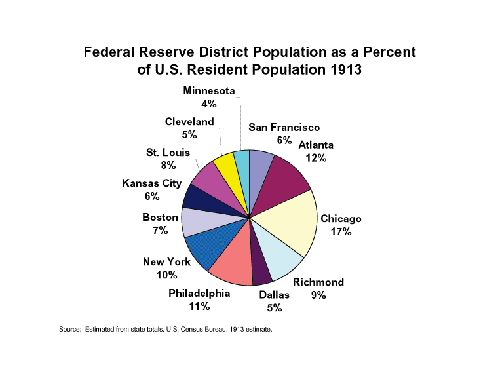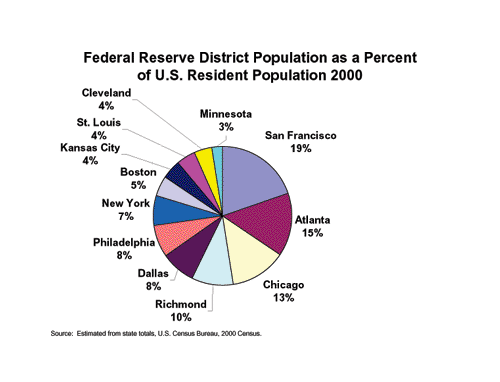The quick answer to your first question is that the Districts were designed to provide central banking services on a regional basis through Reserve Banks headquartered in key financial centers. Even when they were set up in 1913, the Districts varied widely in the population and geographic areas they served. Second, each of the Reserve Banks has a staff of economists who conduct research, provide current analysis, and publish reports and papers on their District economies. That’s the short answer; I’ll go into more detail in the paragraphs to follow.
Competing Interests
The number and location of the 12 Federal Reserve District Banks was the subject of much debate, even before final passage of the Federal Reserve Act in 1913.1 After passage, the Federal Reserve Bank Organization Committee was charged with selecting the number and location of the Federal Reserve Banks and defining the Federal Reserve Districts.
A variety of entities, from financial centers to rural communities, from cities to states, vied for one of the proposed regional Reserve Banks or Reserve Bank Branch offices. The committee held hearings in many cities across the nation to gather input from bankers, the business community, government officials, and the public on where to locate the new Reserve Banks. The committee also conducted a poll of national banks.2
Financial Center Locations
The Committee chose 12 cities as Reserve Bank locations, shown on the map below, in part because of their importance as banking centers in 1913. Most of the Districts with large geographic areas or populations or both, also had Branch offices that were designed to provide central banking services in other parts of the District.3

As selected, the 12 cities and their Districts were not evenly divided in terms of either population or the geographic area they were to serve. For example, state population estimates for 1913 indicate that the Seventh District, headquartered in Chicago, included the largest share of the nation’s population at that time. Chart A shows that the Chicago Fed served a share of U.S. population that was close to four times the share served by the neighboring Ninth District, with its headquarters in Minneapolis. The San Francisco District, even though it encompassed the largest area of the nation’s landmass, accounted for only a small share, about 6 percent, of the nation’s population in 1913.4
CHART A

CHART B

Population Shifts
Over time, the Federal Reserve System’s regional structure of banks and branches has provided central banking services to the nation, even as commerce, financial activity, and population have shifted. For example, since 1913 the share of population accounted for by each Federal Reserve District has changed. Three Districts, San Francisco, Atlanta, and Dallas, have recorded sizeable gains in the share of population since 1913; all but one of the other nine Districts have lost share. The Twelfth District has experienced the largest change; its share of the nation’s population more than tripled from 1913 to 2000. By 2000 the District accounted for nearly one of every five U.S. residents, as Chart B shows.
How Does the SF Fed Provide Central Banking Services to such a Large Region with a Large Population?
The Federal Reserve Bank of San Francisco has four Branch offices, located in Los Angeles, Seattle, Portland, and Salt Lake City. The Bank and its Branches provide a variety of central bank functions, including serving as the U.S. Treasury’s bank. Payments system operations include check processing, electronic funds transfer, automated clearinghouse, coin, and currency services. Another important central bank function includes supervision and regulation of financial institutions. Reserve Banks regulate state-chartered banks that are members of the Federal Reserve System, U.S. operations of foreign banks, bank holding companies, and financial holding companies.
Fed operations have been adjusted from time to time to reflect changing economic situations in the Twelfth District. In 1938 a Branch in Spokane was closed. In September 2001 a new processing center will be opened to handle the increased demand for cash services in the Phoenix area.
How Does the SF Fed Analyze the District Economy?
Analyzing conditions in the large and diverse Twelfth District does present some challenges, but economists like challenges! About half of the San Francisco Fed’s 40 Economic Research department staff members are economists. The research staff advises Federal Reserve Bank of San Francisco President Robert T. Parry on national, international, financial, and regional economic conditions. Much of their research and analysis, including analysis of Twelfth District banking and economic trends, is available from the Bank’s website.
- Beige Book, a survey of regional economic conditions that is conducted eight times per year.
http://www.federalreserve.gov/FOMC/BeigeBook/2001/
- Western Economic Developments, a quarterly (in 2001) analysis of current economic conditions in the Twelfth District.
- Economic Letter, about 40 short essays on a current economic topic, including some regional issues, are published each year.
/publications/economics/letter/
- FedViews, a monthly overview of the current U.S. economic outlook from the Bank’s own economic forecasts.
/publications/economics/fedviews/
- Fed-in-Print, a searchable index of Federal Reserve System Economic Research publications.
-
NOTE: For an update on the Fed’s check processing business, please visit:
Dr. Econ (Q1 2012): Is the Fed still in the business of processing checks?
Endnotes
1. As noted in Historical Beginnings…The Federal Reserve System, by Roger T. Johnson, Federal Reserve Bank of Boston, revised December 1995, the House bill called for at least 12 reserve banks; the Senate bill stipulated between 8 and 12 reserve banks. The House and Senate Conference Committee agreed upon the Senate’s wording, but that left the decision for the Federal Reserve Organization Committee.
2. Ibid. See Chapter 3, Making the System Work, pages 35-51.
3. The Federal Reserve Bank of Atlanta, with five, has the largest number of branches. Two Districts, Boston and Philadelphia, have no branches.
4. 1913 estimates are based on state resident population figures, and exclude the territories of Alaska and Hawaii. The Twelfth District, including Alaska and Hawaii, encompasses about one third of the nation’s area. District population estimates (as a percent of the nation) are calculated at the state level, so that states that are included in two Federal Reserve Districts are allocated to the District with the majority of the state population.
References
Johnson, Roger T. (1995) Historical Beginnings…The Federal Reserve System, Federal Reserve Bank of Boston, revised December 1995. http://www.bos.frb.org/about/pubs/begin.pdf
1913 Census Bureau population estimates: Historical Annual Time Series of State Population Estimates and Demographic Components of Change, 1900 to 1990 Total Population Estimates. http://www.census.gov/population/www/estimates/st_stts.html
2000 Census Bureau Resident population, U.S. Census Bureau. http://www.census.gov/population/www/cen2000/respop.html
Twelve Banks: The Strength of the Federal Reserve, Thomas M. Hoenig, President and Chief Executive Officer Federal Reserve Bank of Kansas City (PDF – 30KB)